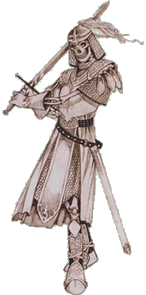|
A History of Dwarves
The Age of Chaos (20,000 to 5,000 Years Old)
<<
PREVIOUS • History
of Dwarves • NEXT >>
 The
traveling clans brought word of Despana to the dwarves in the UnderGrounds.
At first, the dwarves were hesitant to involve themselves in the
Elf battle. However, the humility and sadness from the loss at Shadow
Guard, and the ensuing Elven request for help, prompted Overking
Gerfroth Khazar (a descendant of Khazi Khazar) to send forward 2,500
brave dwarves to lend aid against the threat. It was hardly a victory
at Maelshyve; of the legion of fully armored dwarven troops, less
than a quarter returned. While the survivors sang of great victories
over the undead, and the strange and powerful magics of the elves,
they also mourned the loss of so many kin. The
traveling clans brought word of Despana to the dwarves in the UnderGrounds.
At first, the dwarves were hesitant to involve themselves in the
Elf battle. However, the humility and sadness from the loss at Shadow
Guard, and the ensuing Elven request for help, prompted Overking
Gerfroth Khazar (a descendant of Khazi Khazar) to send forward 2,500
brave dwarves to lend aid against the threat. It was hardly a victory
at Maelshyve; of the legion of fully armored dwarven troops, less
than a quarter returned. While the survivors sang of great victories
over the undead, and the strange and powerful magics of the elves,
they also mourned the loss of so many kin.
With the stories of triumph, and mourning for loss, came a great
plague. The Red Rot, believed to be some last strike or seed of
Despana's magics, infected strong and weak dwarves alike, even Overking
Khazar himself. Very little is said of the plague. The eldest dwarves
speak of it in whispered tones, and nervously. It was a treacherous
disease, causing the skin to bubble into bleeding sores. As the
plague progressed, the victims of the Red Rot would cough and spit
blood, as the disease affected the organs inside as it did the skin
outside. Those affected would spread the disease unintentionally,
as others tried to cure them. There was no cure found, even among
the most learned of the stout race. Nor was there much time to find
one, as the fierce plague swept through the confined caverns of
Kalaza in a matter of weeks, destroying nearly half of the dwarven
population.
It soon became apparent that no cure would be found, as more and
more dwarves became ill. Some believed that the plague was in the
cavern air itself, and staying within Kalaza would mean certain
death. Faced with the threat of extinction, and unable to find a
cure, the dwarven spirit was tested. There were some dwarves that
were not affected, whether immune to the plague, or simply lucky.
Rather than risk facing the same fate as their brethren, they decided
to quarantine the city beneath the mountain. They worked diligently
and destroyed the tunnels and mines leading from Kalaza, and buried
the entrance to the great city under an avalanche of rock, never
to look back. According to myth, a simple rune marks the entrance
to Kalaza, a rune that only a dwarven miner would recognize, one
that means simply, "Farewell."
Mournful of their loss, but persevering in their spirit, the dwarves
left Kalaza forever, traveling to where they thought to find the
most comfort, safety or profit, with those that remained of their
clans. Some of the established mines were already a great distance
from Kalaza, and others instead sought new areas to re-establish
their families. This was called the Great Emigration, and it was
this terrible event that caused those clans that dwelled in Kalaza
to migrate and become even more widely dispersed throughout the
DragonSpine.
|



 The
traveling clans brought word of Despana to the dwarves in the UnderGrounds.
At first, the dwarves were hesitant to involve themselves in the
Elf battle. However, the humility and sadness from the loss at Shadow
Guard, and the ensuing Elven request for help, prompted Overking
Gerfroth Khazar (a descendant of Khazi Khazar) to send forward 2,500
brave dwarves to lend aid against the threat. It was hardly a victory
at Maelshyve; of the legion of fully armored dwarven troops, less
than a quarter returned. While the survivors sang of great victories
over the undead, and the strange and powerful magics of the elves,
they also mourned the loss of so many kin.
The
traveling clans brought word of Despana to the dwarves in the UnderGrounds.
At first, the dwarves were hesitant to involve themselves in the
Elf battle. However, the humility and sadness from the loss at Shadow
Guard, and the ensuing Elven request for help, prompted Overking
Gerfroth Khazar (a descendant of Khazi Khazar) to send forward 2,500
brave dwarves to lend aid against the threat. It was hardly a victory
at Maelshyve; of the legion of fully armored dwarven troops, less
than a quarter returned. While the survivors sang of great victories
over the undead, and the strange and powerful magics of the elves,
they also mourned the loss of so many kin.